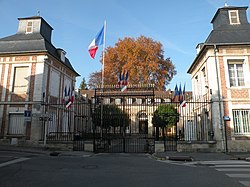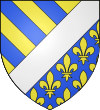Oise (département)
| Oise | ||
|---|---|---|
| Department | ||

Prefecture building of the Oise department, in Beauvais
|
||
|
||
 Location of Oise in France |
||
| Coordinates: 49°23′N 02°25′E / 49.383°N 2.417°ECoordinates: 49°23′N 02°25′E / 49.383°N 2.417°E | ||
| Country | France | |
| Region | Hauts-de-France | |
| Prefecture | Beauvais | |
| Subprefectures |
Clermont Compiègne Senlis |
|
| Government | ||
| • President of the General Council | Yves Rome | |
| Area | ||
| • Total | 5,860 km2 (2,260 sq mi) | |
| Population (2013) | ||
| • Total | 815,400 | |
| • Rank | 26th | |
| • Density | 140/km2 (360/sq mi) | |
| Time zone | CET (UTC+1) | |
| • Summer (DST) | CEST (UTC+2) | |
| Department number | 60 | |
| Arrondissements | 4 | |
| Cantons | 21 | |
| Communes | 687 | |
| ^1 French Land Register data, which exclude estuaries, and lakes, ponds, and glaciers larger than 1 km2 | ||
Oise (French pronunciation: [waz]) is a department in the north of France. It is named after the river Oise. Natives of the department are called Isariens.
Oise is one of the original 83 departments created during the French Revolution on March 4, 1790. It was created from part of the province of Île-de-France and Picardy.
After the coalition victory at Waterloo, the department was occupied by British troops between June 1815 and November 1818.
Oise is part of the current region of Hauts-de-France and is situated 35 km north of Paris. It is surrounded by the departments of Somme, Aisne, Seine-et-Marne, Val-d'Oise, Eure, and Seine-Maritime.
The major tourist attraction of the department is the Parc Astérix, which opened in 1989. Another very interesting site is Beauvais Cathedral. Also to be seen is the Chateau de Pierrefonds, restored by Viollet-le-Duc. The art collection of the Château de Chantilly is one of the largest outside Paris.
...
Wikipedia

